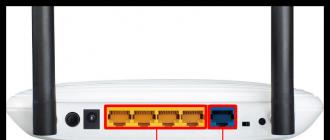Most modern computer users mobile devices or television panels came across such a concept as VGA. Is it a connector, video adapter, monitor, driver, cable or adapter? Unfortunately, many of us, as a rule, do not have a clear understanding of this issue. Therefore, it is worth dwelling on this standard in more detail.
VGA: what is it in a general sense?
First, a few words about the standard itself. In its broadest sense, VGA is not the individual components listed above, but a complete component-type video interface originally developed by IBM for its computers.
Thus, both hardware and software components are included in the understanding of the entire technology of image reproduction or transmission, and the functioning of the interface consists in their interaction.
The history of the emergence of the standard
Now a few words about the emergence of the VGA video standard. We figured out a little what it is. The technology was first introduced by IBM in 1987 on PS / 2 computers.

VGA adapter, unlike its predecessors and successors, used (and uses) for high-quality image transmission analog signal... But along the way, the question arises of why the introduction of the new standard was needed. To fully understand such a solution, you need to refer to the main parameters of the devices themselves.
Main characteristics
The first and one of the main factors in the transition to this standard, most experts call the moment that initially it was necessary to reduce the number of wires in the main cable with the ability to connect system units via a VGA graphics adapter to the corresponding monitors, which were able to transmit much more colors and shades than before. At the same time, a higher picture resolution was achieved.

Itself today has a structure, which includes the following elements:
- graphic controller for data exchange between video memory and central processor based on bit operations with data;
- video memory DRAM 256 KB, divided into four color layers;
- serial converter of video memory data into bits for transferring attributes to the controller;
- an attribute controller for converting input data to palette-based color values;
- synchronizer to control layer switching and timing parameters of the graphics adapter;
- a cathode-ray tube controller for generating synchronization signals with the monitor.
Provided that the VGA driver is installed in the system, the maximum resolution is 640x480 pixels per inch with a color depth of up to 32 bits. Of course, at the time the standard appeared, it was truly a revolution. But today you can find much higher resolutions, which is achieved through the use of digital technologies. But as it turns out, even at the current stage of development of computer technology, the VGA standard cannot be discounted. What does it mean? Yes, only that for the transmission of the image, as already mentioned, an analog signal is used, which can be converted into any other. In addition, the size of the adapter itself is greatly reduced and can be integrated directly into motherboard or additionally to the video card.
Here it is worth paying attention also to the fact that digital signal has a wider bandwidth, and MPEG coding technology is used to transmit such a signal. This, in turn, leads to a loss of quality.
VGA monitors and TVs
Since the appearance of the main standard, the corresponding monitors began to be actively used, and after that, the television panels of this interface (for example, LCD devices).

Today, this abbreviation is used to designate all graphic modes, including monitors that are capable of supporting a resolution of 640x480 pixels, regardless of the hardware component. At the current stage of development, they are practically not used, although at one time they were very popular.
Graphics adapters
Almost all modern graphics accelerators (video cards), be they integrated or discrete, support the main modes of the described interface and are equipped with the corresponding outputs (ports), which are sometimes referred to as D-Sub.

In other words, a video card can have multiple video outputs. And the VGA connector is mandatory. By the way, such connectors can be found on the rear panels of stationary system units and on the side walls of laptops.
Drivers
It goes without saying that no graphics accelerator will work if the appropriate driver is not installed for it (including the VGA driver).

But for modern video cards, such control programs need not be installed from databases. operating systems, and from distributions of equipment manufacturers. In addition, today management or overclocking utilities are widely used, supplied for the most popular nVIDIA cards and Radeon.
Many gamers can make sure that the VGA driver is working correctly by setting the video mode 640x480 or its non-standard variations in the game settings. Actually, the same situation is observed when connecting a computer or laptop to a high-definition TV panel, if a VGA cable is used (and not only with the same type of connectors on both sides).
Types of cables and adapters
Since there are a lot of connection options for completely different video interfaces, it is worthwhile to dwell on cables with adapters that can be used to convert the image transmission according to a scheme that will be recognized by both the receiving and transmitting devices.

As an example, consider a VGA cable with different transition options. Among the main ones (except for the usual type), the following can be distinguished:
- VGA-DVI (used on some video cards that do not have a VGA connector, although they support the corresponding operating modes);
- VGA-HDMI (can be used to connect older computers or laptops to modern TVs and projectors);
- VGA-RCA or VGA-"tulip" (used to connect modern computer systems, not equipped with VGA connectors, to old TVs or monitors with CRTs ELP);
- VGA-HDMI-RCA-mini-Jack (variation of combining the two previous adapters for connection with sound transmission - no sound is transmitted through VGA);
- VGA-S-Video (less popular option for connecting to TVs).
The main connector of the standard, also referred to as DE15F, in any of the variants is a 15-pin connector on one side, which allows transmitting a signal based on progressive scanning technology, in which the voltage change corresponds to the change in the brightness of the ELP (the intensity of the beam of the monitor gun or the kinescope).
Summary and conclusions
That's all there is to understanding VGA. What it is? In fact, this is exactly the interface, and not its individual components necessary for correct functioning. And as you can already see, it is present in most modern computer devices. Although the prospects for the development of such technologies look very vague, nevertheless, so far no one is going to abandon them.
It remains to add that this standard, despite the appearance of its followers in the form of the same Super VGA or XGA interface, still remains one of the most popular and demanded all over the world and on all types of devices, including computers, laptops, TV panels or even mobile gadgets.
When asked the people, explain what does qVGA and just a VGA display mean? given by the author Dmitriy the best answer is Quarter Video Graphics Array (also known as Quarter VGA or QVGA). Popular term for computer monitors with a resolution of 320 × 240.QVGA displays are often seen in cell phones, PDAs and pocket game consoles... They are most commonly used in portrait mode (the opposite of landscape) and are referred to as 240x320 because the displays are taller than they are wide. The name is derived from the fact that this mode represents 1/4 of 640x480, the maximum resolution of the original IBM VGA video adapter, which became the de facto industry standard in the late 1980s.
The term QVGA is also used in digital video modes for more economical recording, typical of multifunction devices such as digital cameras (e.g. Fujifilm FinePix S602) or cell Phones (such as Pantech PH-L4000V, Samsung SGH-D600). Each frame is a 320 × 240 pixel image. For QVGA video, 15 or 30 frames per second are typical. QVGA mode only refers to the resolution used, not the video file format.
IN high resolutions The “Q” prefix sometimes means “Quad” or quadruple resolution (eg QXGA at 2048x1536).
VGA (Video Graphics Array) is a standard for monitors and video adapters. Released by IBM in 1987 for PS / 2 Model 50 computers and older. VGA was the latest standard followed by most video card manufacturers.
The VGA video adapter connects to both color and monochrome monitors, while all standard video modes are available. The refresh rate of the screen in all standard modes, except 640 × 480, is 70 Hz, in the 640 × 480 mode - 60 Hz. The video adapter has the ability to simultaneously display 256 different colors, each of which can take one of 262 144 different meanings (6 bits each for red, green and blue components). The volume of video memory VGA - 256 kB.
The VGA video adapter, unlike previous IBM video adapters (MDA, CGA, EGA), uses an analog signal to convey color information. The transition to an analog signal was due to the need to reduce the number of wires in the cable. Also, the analog signal made it possible to use VGA monitors with subsequent video adapters, which can display more colors.
The official successor to VGA was the IBM XGA standard, but in fact it was replaced by various VGA extensions known as SVGA.
The term VGA is also often used to refer to 640x480 resolution regardless of the display hardware, although this is not entirely true (for example, 640x480 mode with 16-, 24- and 32-bit color depth is not supported by VGA adapters, but can be generated on a monitor designed to work with a VGA adapter using SVGA adapters). Also this term is used to refer to 15-pin D-subminiature vGA connector for transmitting analog video signals at different resolutions.
Every PC user sooner or later is faced with the connection of his laptop or personal computer to the monitor using various cables and connectors. All of them differ among themselves structure, picture quality and maximum allowable cable length. In the 90s to connect CRT monitors used a 15-pin VGA connector, which gave out good picture for that time. Over time, the resolution that VGA gives out became insufficient and it was replaced by a new 17 (17-29) pin DVI interface with the ability to display a much higher resolution due to its more bandwidth.
DVI connector
For the development of the Digital Visual Interface (DVI) large companies have combined their efforts. It was jointly decided that it was not expedient to convert the signal twice. As a result, the developers came to the decision to create a single digital interface, which will be able to display the original image without unnecessary changes and loss of quality.
Basic working principleinterface is new technology TMDS data encoding protocol. The information previously implemented by the protocol is sequentially transmitted to the device.
The interface allows you to achieve a resolution of 1920x1080 at a frequency of 60 Hz. Such parameters can be achieved throughput 1.65 Gb / s and this is when using one TMDS connection. If two connections are used, then the speed will increase to 2 Gb / s. At such high rates, DVI is head and shoulders above its predecessors.
For a simple user, you can explain why the Digital Visual Interface is so good by saying that it is a digital video interface. It is not difficult to distinguish it from its analog predecessor - the connectors are always white, which makes it impossible to confuse it with others. The shape and more pins are also a characteristic feature of the interface.
The interface cable is limited in length, like other connectors, its maximum length is no more than 10 m, which is 7 meters more than VGA.
Main types and differences
In addition to the characteristic differences from other interfaces, the Digital Visual Interface also differs from each other. The main differences between them are the number of channels and the ability to transmit an analog signal. Let's consider the popular variations in more detail:

To summarize the difference between the connectors, you can simply - the letter D indicates the presence of only a digital signal, the letter A - only analog, the letter I indicates the presence of both types of signal. 
In the case when the video card has a Digital Visual Interface output, and on the monitor only VGA adapters are suitable. When purchasing adapters, you need to understand the difference between DVI-I and DVI-D, the former will be able to transmit the signal to VGA since present analog channel, but the second does not have an analog communication channel and it will not work to transmit the image through it through the adapter, for this they use special expensive converters.
In addition to DVI-VGA and VGA-DVI adapters, there are other DVI-HDMI, HDMI-DVI, DVI-DisplayPort, DisplayPort-DVI, all of them transfer a digital signal between themselves and there should be no problems with connection.
Disadvantages of technology
The only significant drawback of the technology is cable length limitation... For example, when using a 15 m cable, the maximum resolution that can be achieved is 1280x1024, but if you use only a 5 meter cable, the resolution will increase to 1920x1200. If you need to connect the device over a long distance without signal loss, you will have to use additional repeatersthat will amplify the signal.
VGA connector
In 1987, Canon provided the world with a new VGA (Video Graphics Array) connector, which was installed on the video card of the same name. The capabilities of the technology were more than enough, because the original resolution was 640x480. The maximum possible resolution without loss of image quality that the Video Graphics Array is capable of producing is 1280x1024. Although more efficient interfaces have been around for a long time, pushing VGA out of the market, many TVs and video devices still come with this connector. The reason for the crowding out was the emergence of new monitors that require higher resolutions.
The connector has a 15-pin pinout and is marked in blue (with rare exceptions), which makes it easy to distinguish it from DVI (white). Maximum cable length for connection is limited to 3 m.
As technology advances, a new standard, Super Video Graphics Array, or SVGA, has emerged that uses the same 15-pin connection as Video Graphics Array, but significantly surpasses it technically. The main difference between SVGA and VGA is number of displayed colors, them in new version the interface has become 16 million, with 256 colors from the old one.
Main types
Have VGA connectors there are three main types of DDC1, DDC2, E-DDC:
- DDC1 - allows the monitor to unilaterally transfer data with information about its characteristics to a computer. Then the video card determines this information on the cable and detects the DDC monitor connected to it
- DDC2 - a specification of this type already allows the exchange of information in a two-way manner. First, the monitor transmits its data to the computer, after which the computer adjusts required parameters under the connected monitor.
- E-DDC - represents the most efficient specification. Information about the connected monitor data was stored in the device memory.
All 15 contacts are arranged in 3 rows of 5 contacts. First three contacts are responsible for the transmission of an analog video signal of three different colors (1,2,3). Each of them has its own land - 6,7,8 respectively. 13 and 14 contacts are responsible for horizontal and vertical synchronization. In addition to video signal transmission, the interface has two-way communication with the monitor.
Interface pinout:

If we are talking about a mini VGA mini-connector (a reduced analogue with the same parameters), then the pinout will be as follows:

Extension cords
There are situations when the computer and the connected monitor or TV are in different rooms and a non-standard cable is required to connect them. You can buy it at any computer store, but two problems arise:
- too high price cable - from $ 20 for 15 meters;
- rigidity standard cablewhat becomes big problem for a beautiful and correct installation in skirting boards. If, when installing the cable, you need to go through the wall, then the factory cable will obviously not help. you will have to drill a hole with a diameter of 40 mm.
IN similar cases the ideal solution would be to make an extension cord yourself. This is where the usual twisted pair 5 or 6 categories. 
In terms of price, it significantly outperforms the factory Video Graphics Array extension cable, its price is about 15 rubles per meter, and its diameter is only 8 mm.
Using only 8 twisted pair pins, you can easily solder an extension cord, but you can do it even easier by buying a VGA to RJ-45 adapter in the store. 
DVI-D - DIY VGA adapter
It is impossible to find such an adapter. This is due to the fact that technologies use different ports and data types. If you look closely at the DVI-D pinout, you will notice that it has no contacts to carry the analog signal that VGA requires.
In this case, it can help converterDVI-D - VGA, which converts the digital signal from the Digital Visual Interface to analog. This is the only connection option.
Worth noticingthat if you break off 4 "extra pins" because of which the usual adapter is not inserted into the connector, then nothing will work anyway, since it is they who are responsible for transmitting the analog signal. 
Maximum cable length
All interfaces are limited to the maximum allowable cable length at which the signal quality is not lost. The longer the cable is, the worse signal, and accordingly the maximum resolution. The maximum length is different for each type, since the interfaces use different technologies and types of signals.
For DVI - 10, VGA - 3 m, HDMI - 10 m.
Difference between DVI and VGA
The main difference between these connectors is maximum resolution and picture quality... In addition, the Digital Visual Interface has 17 to 29 pins, while the VGA is only 15. Another difference is the type of signals with which the interfaces work: for VGA it is analog, and for Digital Visual Interface it is digital. It is for this reason that VGA has to be converted twice, which significantly degrades the quality of the resulting image.
Which is better DVI or HDMI
Comparing these two interfaces, we can say about their certain equivalence. The big advantage of HDMI is that with just one cable, you can transfer both video and audio data, thereby reducing the number of wires that are abundant in modern multimedia systems. The essential difference is maximum resolution, which at the moment HDMI can be 10240 × 5760.
Difference between VGA and HDMI
It is incorrect to compare these two interfaces due to their creation time difference. HDMI is a fairly new connector that provides the user with great picture and great sound in just one cable. Video Graphics Array is currently used mostly in old technique not compatible with new technologies.
VGA (eng. Video Graphics Array) - the standard of monitors and video cards. Released by IBM in 1987 for PS / 2 Model 50 and higher computers. VGA was the last benchmark followed by most video card manufacturers.
In most cases, the term VGA is used in one of three meanings:
Maybe you can also use:






